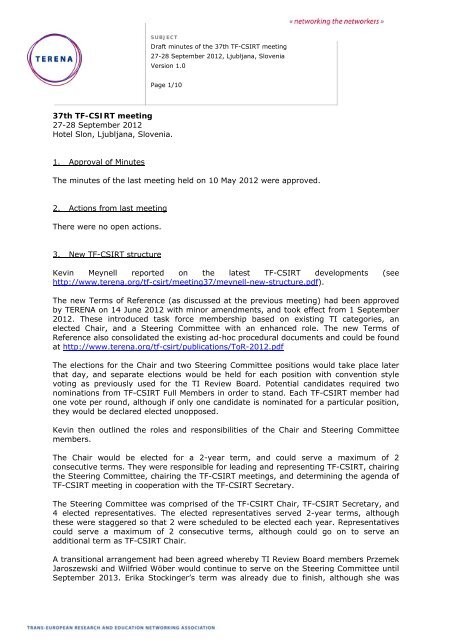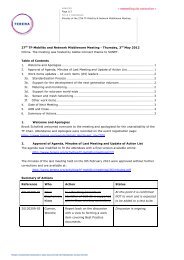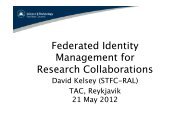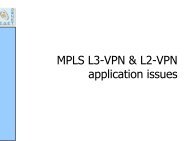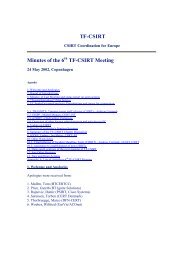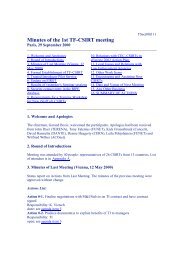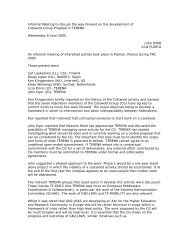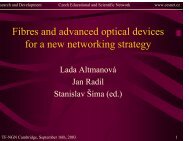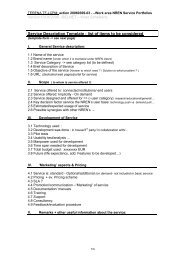Minutes of the meeting - Terena
Minutes of the meeting - Terena
Minutes of the meeting - Terena
You also want an ePaper? Increase the reach of your titles
YUMPU automatically turns print PDFs into web optimized ePapers that Google loves.
SUBJECTDraft minutes <strong>of</strong> <strong>the</strong> 37th TF-CSIRT <strong>meeting</strong>27-28 September 2012, Ljubljana, SloveniaVersion 1.0Page 1/1037th TF-CSIRT <strong>meeting</strong>27-28 September 2012Hotel Slon, Ljubljana, Slovenia.1. Approval <strong>of</strong> <strong>Minutes</strong>The minutes <strong>of</strong> <strong>the</strong> last <strong>meeting</strong> held on 10 May 2012 were approved.2. Actions from last <strong>meeting</strong>There were no open actions.3. New TF-CSIRT structureKevin Meynell reported on <strong>the</strong> latest TF-CSIRT developments (seehttp://www.terena.org/tf-csirt/<strong>meeting</strong>37/meynell-new-structure.pdf).The new Terms <strong>of</strong> Reference (as discussed at <strong>the</strong> previous <strong>meeting</strong>) had been approvedby TERENA on 14 June 2012 with minor amendments, and took effect from 1 September2012. These introduced task force membership based on existing TI categories, anelected Chair, and a Steering Committee with an enhanced role. The new Terms <strong>of</strong>Reference also consolidated <strong>the</strong> existing ad-hoc procedural documents and could be foundat http://www.terena.org/tf-csirt/publications/ToR-2012.pdfThe elections for <strong>the</strong> Chair and two Steering Committee positions would take place laterthat day, and separate elections would be held for each position with convention stylevoting as previously used for <strong>the</strong> TI Review Board. Potential candidates required twonominations from TF-CSIRT Full Members in order to stand. Each TF-CSIRT member hadone vote per round, although if only one candidate is nominated for a particular position,<strong>the</strong>y would be declared elected unopposed.Kevin <strong>the</strong>n outlined <strong>the</strong> roles and responsibilities <strong>of</strong> <strong>the</strong> Chair and Steering Committeemembers.The Chair would be elected for a 2-year term, and could serve a maximum <strong>of</strong> 2consecutive terms. They were responsible for leading and representing TF-CSIRT, chairing<strong>the</strong> Steering Committee, chairing <strong>the</strong> TF-CSIRT <strong>meeting</strong>s, and determining <strong>the</strong> agenda <strong>of</strong>TF-CSIRT <strong>meeting</strong> in cooperation with <strong>the</strong> TF-CSIRT Secretary.The Steering Committee was comprised <strong>of</strong> <strong>the</strong> TF-CSIRT Chair, TF-CSIRT Secretary, and4 elected representatives. The elected representatives served 2-year terms, although<strong>the</strong>se were staggered so that 2 were scheduled to be elected each year. Representativescould serve a maximum <strong>of</strong> 2 consecutive terms, although could go on to serve anadditional term as TF-CSIRT Chair.A transitional arrangement had been agreed whereby TI Review Board members PrzemekJaroszewski and Wilfried Wöber would continue to serve on <strong>the</strong> Steering Committee untilSeptember 2013. Erika Stockinger’s term was already due to finish, although she was
Page 2/10SUBJECTDraft minutes <strong>of</strong> <strong>the</strong> 37th TF-CSIRT <strong>meeting</strong>27-28 September 2012, Ljubljana, Sloveniaeligible to stand for election again.The Steering Committee usually met three times per year at TF-CSIRT <strong>meeting</strong>s,although occasionally held additional teleconferences. Its responsibilities were as follows:• Making decisions on CSIRT accreditation and certification in accordance with <strong>the</strong>guidelines. This was a responsibility inherited from <strong>the</strong> TI Review Board.• Reviewing <strong>the</strong> performance <strong>of</strong> <strong>the</strong> Trusted Introducer service and makingrecommendations to modify or expand it. This was a responsibility inherited from <strong>the</strong>TI Review Board.• Overseeing <strong>the</strong> development <strong>of</strong> <strong>the</strong> TRANSITS training curricula and course materials,monitoring tutoring standards, and registration <strong>of</strong> tutors.• Coordinating <strong>the</strong> activities <strong>of</strong> TF-CSIRT and recommending courses <strong>of</strong> action whereissues occur.• Advising on future developments and strategic directions in computer security. Thiswas mostly envisaged with respect to <strong>the</strong> TF-CSIRT community ra<strong>the</strong>r than advisingexternal bodies on behalf <strong>of</strong> TF-CSIRT.• Providing input on <strong>meeting</strong> agendas.Finally, <strong>the</strong> new TF-CSIRT logos were shown. These had been modified from thosepreviewed at <strong>the</strong> previous <strong>meeting</strong> in response to <strong>the</strong> feedback received.Kauto raised a query about <strong>the</strong> Steering Committee advising on future developments andstrategic directions. Kevin replied this was intended to mean advising <strong>the</strong> TF-CSIRTcommunity, ra<strong>the</strong>r than advising external parties. In <strong>the</strong> past though, <strong>the</strong> TF-CSIRT Chairand TERENA had occasionally been asked to comment on CSIRT and computer securitymatters, even though it was always made clear that individual CSIRTs might havedifferent viewpoints. It would <strong>the</strong>refore be better if elected representatives <strong>of</strong> <strong>the</strong> TF-CSIRT community could be consulted in <strong>the</strong>se matters.Andrew Cormack suggested that ‘informed’ might be a better term than ‘advise’.Mat<strong>the</strong>w Cook suggested having <strong>the</strong>med slots during TF-CSIRT <strong>meeting</strong>s. Kevin said thissuggestion would be taken on board for future <strong>meeting</strong>s.4. RU-CERT presentationDimitry Ippolitov gave a presentation about RU-CERT (see http://www.terena.org/tfcsirt/<strong>meeting</strong>37/ippolitov-ru-cert.pdf).RU-CERT provided an incident prevention and response service for all users located inRussia, with <strong>the</strong> exception <strong>of</strong> government facilities that were covered by <strong>the</strong> governmentCERT. They also provided assistance in contacting o<strong>the</strong>r Russian incident response teams,abuse services and law enforcement agencies.RU-CERT was sponsored by <strong>the</strong> Russian Institute for Public Networks (RIPN) which was anon-governmental not-for-pr<strong>of</strong>it organisation that coordinated and facilitated access topublic networks. The team currently comprised 5 full-time people.? asked whe<strong>the</strong>r RU-CERT had any contact with CERT-GIB. Dimitry replied <strong>the</strong>y knew<strong>the</strong>m, but did not regularly communicate with <strong>the</strong>m.
Page 3/10SUBJECTDraft minutes <strong>of</strong> <strong>the</strong> 37th TF-CSIRT <strong>meeting</strong>27-28 September 2012, Ljubljana, Slovenia5. CERT-Bund presentationMichael Dwucet gave a presentation about CERT-Bund (see http://www.terena.org/tfcsirt/<strong>meeting</strong>37/dwucet-cert-bund.pdf).It operated under <strong>the</strong> Federal Office forInformation Security and provided incident handling and response services to <strong>the</strong> GermanFederal Government, as well as being a CSIRT <strong>of</strong> last resort. It had been operational since1994 (originally as BSI-CERT) and currently comprised 15 people.CERT-Bund aimed to provide incident warning and response services, but also closelycollaborated with <strong>the</strong> National IT Situation Centre that monitored <strong>the</strong> current state <strong>of</strong>government networks, and <strong>the</strong> National IT Crisis Reaction Centre that could respond toserious incidents. They also had a close working relationship with DFN-CERT and variousindustrial and commercial CSIRTs. In addition, <strong>the</strong>y participated in <strong>the</strong> CERT Verbund thatcomprised around 30 o<strong>the</strong>r teams.Serge Droz commented that it had always been difficult to liaise with German CSIRTsbecause <strong>of</strong> restrictive data protection laws. He asked whe<strong>the</strong>r this situation was likely tobe resolved in future.6. ENISA-CERT relationsAndrea Dufkova reported on <strong>the</strong> latest ENISA developments.The ENISA training materials had been extended to include mobile device forensics,investigation <strong>of</strong> DDoS traces, NetFlow analysis and honeypot deployment. There was alsoadditional material on developing CSIRT infrastructures, establishing external relations,and costing security incidents.ENISA was also conducting a follow-on study in early warning systems, and in particularwhe<strong>the</strong>r honeypots were useful for CSIRTs. Are <strong>the</strong>y a practical tool for developingintelligence about threats, and who is undertaking <strong>the</strong> attacks?The CERT Inventory Map that displayed all <strong>the</strong> known CSIRTS in <strong>the</strong> European Region hadbeen re-designed and updated, whilst <strong>the</strong> <strong>the</strong> European Information Sharing and AlertSystem (EISAS) was being piloted by CESICAT, CertHU, CertPL, NorSIS, DeutscheTelekom and La Caixa.In addition, <strong>the</strong> 7 th CERT workshop would be held on 16-17 October 2012 in Den Haag,<strong>the</strong> Ne<strong>the</strong>rlands. This would focus on developing cooperation betweennational/government CERTs and <strong>the</strong>ir national law enforcement counterparts.Andrea <strong>the</strong>n discussed <strong>the</strong> latest report on baseline capabilities <strong>of</strong> national andgovernment CSIRTs that would shortly be published. The aim <strong>of</strong> <strong>the</strong> study was to defineand agree on minimum capabilities for national and government CSIRTs, in order toimprove incident response and handling at <strong>the</strong> national and cross-border level.National and government CSIRTs had been established in nearly all EU Member States,and have capabilities in line with <strong>the</strong> recommendations issued by ENISA in 2009. Therewas a lot <strong>of</strong> variety in how such CSIRTs were established and hosted, although <strong>the</strong>re wasa trend towards creating national cybersecurity centres.A great deal <strong>of</strong> work was still needed to properly incorporate such CSIRTs into nationalcybersecurity strategies, and indeed only 50% <strong>of</strong> EU member states had nationalstrategies at all. On <strong>the</strong> positive side though, 90% <strong>of</strong> national and government CSIRTswere involved in <strong>the</strong> development <strong>of</strong> laws and strategies in <strong>the</strong> area <strong>of</strong> cybersecurity.
Page 4/10SUBJECTDraft minutes <strong>of</strong> <strong>the</strong> 37th TF-CSIRT <strong>meeting</strong>27-28 September 2012, Ljubljana, SloveniaO<strong>the</strong>r concerns were lack <strong>of</strong> funding and staffing, which led to insufficient specialisation inareas such as forensics, vulnerability handling, legal issues and public relations. Therewas sometimes also reluctance for commercial constituents to share information forcompetitive reasons, although informal approaches could still be effective.Most <strong>of</strong> <strong>the</strong> outstanding issues could be defined as political and legal, although as with <strong>the</strong>rest <strong>of</strong> <strong>the</strong> CSIRT community, national and government CSIRTs needed to be willing torespond to new cybersecurity challenges that arose.Michael Dwucet asked whe<strong>the</strong>r ENISA could provide support for developing incidenthandling s<strong>of</strong>tware such as RTIR. Andrea said this was not in <strong>the</strong> current programme, but<strong>the</strong> programme for 2014 would be agreed this coming November. This should bediscussed with representatives <strong>of</strong> <strong>the</strong> ENISA Stakeholder Group, <strong>of</strong> which AndrewCormack was one.7. Ransomware CasesPrzemek Jaroszewski reported on some ransomware cases that had recently been seen inPoland.Otmar Lendl said <strong>the</strong>y had been seeing similar things in Austria, although <strong>the</strong>re seemedto be two different strains <strong>of</strong> ransomware. Kauto Huopio added <strong>the</strong> Finnish lawenforcement authorities were actually paying attention to this problem due to <strong>the</strong>financial demands being made, so it was important to communicate cases.8. Fake CollegesJames Davis gave a presentation about fake college websites that seemed to be springingup in <strong>the</strong> UK. These were <strong>of</strong> varying quality, but some appeared to be very pr<strong>of</strong>essionaleven though provided postal addresses were o<strong>the</strong>r businesses, and telephone numberswere diverted to mobile phones.It was unclear why <strong>the</strong>se sites were being created and who was doing it. One possibilitywas an immigration scam in order for people to obtain student visas, but <strong>the</strong> immigrationauthorities could easily check institutions against an accredited list so this seemedimplausible. Ano<strong>the</strong>r possibility was for issuing false diplomas, but none <strong>of</strong> <strong>the</strong> sitesactually appeared to be <strong>of</strong>fering anything like this.James <strong>the</strong>refore asked whe<strong>the</strong>r anyone else had encountered this, or had any idea <strong>of</strong> whyit was being done.Serge Droz suggested that someone could pose as a potential student to see where it led.It would probably need to be done from outside <strong>the</strong> UK to be convincing, but it could bean interesting exercise.9. X-ARF DevelopmentsTorsten Voss reported on <strong>the</strong> latest X-ARF developments (see http://www.terena.org/tfcsirt/<strong>meeting</strong>37/voss-x-arf.pdf).They wished to add optional end-to-end security for X-ARF messages ei<strong>the</strong>r using S/MIMEor PGP/MIME. In order to maintain backwards compatibility, <strong>the</strong> plan was to use ‘X-XARF:
Page 5/10SUBJECTDraft minutes <strong>of</strong> <strong>the</strong> 37th TF-CSIRT <strong>meeting</strong>27-28 September 2012, Ljubljana, SloveniaPLAIN’ or ‘X-XARF: SECURE’ in <strong>the</strong> mail header to indicate <strong>the</strong> use <strong>of</strong> X-ARF v0.2 and that<strong>the</strong> RFC822 container is signed and/or encrypted. That would allow existing importers andexporters to handle legacy X-ARF messages without change.10. Report on Academic CSIRT workshopKevin Meynell gave a short report on <strong>the</strong> second Academic CSIRT workshop (seehttp://www.terena.org/tf-csirt/<strong>meeting</strong>37/meynell-academic-csirts.pdf).This was a one-day <strong>meeting</strong> organised on 17 June 2012 at FIRST 24 in Malta, andinvolved 22 academic CSIRTs from Europe, Asia and Latin America. The aim was todiscuss particular issues affecting CSIRTs serving NRENs and R&E institutions.Presentations can be found at http://www.terena.org/tf-csirt/academic-<strong>meeting</strong>-2/RedCLARA, <strong>the</strong> Latin American R&E network, had established a working group <strong>of</strong> NRENCSIRTs known as GT-CSIRT. This coordinated by Nina Solha (RNP) and covered 15countries in Latin America. Its activities included malicious activity monitoring (using <strong>the</strong>SurfIDS tool), security incident monitoring (using Shadowserver, zone-h and Spamcop),encouraging <strong>the</strong> establishment <strong>of</strong> new CSIRTs along with training, and development <strong>of</strong> aweb-based contacts and incidents manager.There was also a proposal to establish an Academic CSIRT Special Interest Group withinFIRST. This was being followed-up by Margrete Raaum (UiO-CERT & FIRST).11. Election <strong>of</strong> TF-CSIRT <strong>of</strong>ficialsLionel Ferette was <strong>the</strong> only nominated candidate for Chair, so was declared unelectedunopposed for a 2-year term.There were three nominated candidates for <strong>the</strong> two Steering Committee positions, so twoelections were necessary:Position No. 11 st round - Kauto Huopio, 16 votes; Erika Stockinger, 13 votes; Jacques Schuurman, 12votes (eliminated)2 nd round – Erika Stockinger, 22 votes (elected); Kauto Huopio, 21 votesPosition No. 21 st round – Jacques Schuurman, 25 votes (elected); Kauto Huopio, 18 votesErika Stockinger (CERT-SE) and Jacques Schuurman (XS4ALL) were <strong>the</strong>refore elected fora 2-year term each.12. Examining incident handling proceduresOtmar Lendl gave a presentation about incident handling procedures.
Page 6/10SUBJECTDraft minutes <strong>of</strong> <strong>the</strong> 37th TF-CSIRT <strong>meeting</strong>27-28 September 2012, Ljubljana, Slovenia13. Squaring <strong>the</strong> Circle: Reflections on Identities, AuthN & AuthZ at CERNStefan Lüders gave a presentation on two-factor au<strong>the</strong>ntication at CERN (see http://www.terena.org/tf-csirt/<strong>meeting</strong>37/lueders-identities.pdf).This was motivated by <strong>the</strong> traditional lack <strong>of</strong> control over users and accounts at CERNwhich experienced a high turnover <strong>of</strong> staff who tended to have an open and collaborativemindset. It was relatively easy to obtain an account at CERN, and this resulted in amultitude <strong>of</strong> accounts and websites that were all using CERN computing resources evenonce <strong>the</strong> users moved on (or were never actually associated with CERN in <strong>the</strong> first place).The plan was <strong>the</strong>refore to introduce a single sign-on portal for all computing services,which would also allow proper au<strong>the</strong>ntication mechanisms and authorisation to beundertaken. Beyond this, <strong>the</strong> idea was to utilise identity federations so that CERN userscould use accounts from <strong>the</strong>ir home institutions. However, <strong>the</strong> more identity federationsthat were joined, <strong>the</strong> more complexity, so trust networks like IGTF ultimately needed toconsidered. This was currently under discussion at <strong>the</strong> Federated Identity Management(FIM) Workshops.14. Catering for Increased Network Capacities in Anomaly Detection ToolsJuan Quintanilla gave a presentation on <strong>the</strong> NSHaRP service (see http://www.terena.org/tf-csirt/<strong>meeting</strong>37/quintanilla-anomaly-detection.pdf). This was based on Netreflex 2.5,Nfsen and Splunk and provided an automated anomaly detection and alerting system for<strong>the</strong> GÉANT network.The forthcoming GÉANT Plus network would bring some new challenges though, as itwould move to 100 Gb/s circuits and would converge <strong>the</strong> production IP and bandwidthon-demandprovisioning layers. In addition, <strong>the</strong> GÉANT Lambda services (point-to-point10 Gb/s lightpaths) may need to be supported.This meant more hardware capacity was required, as well as s<strong>of</strong>tware that could copewith <strong>the</strong> increased bitrates and number <strong>of</strong> flows. NetReflex 2.9 was <strong>the</strong>refore being rolledout in a staged migration, and approximately three-quarters <strong>of</strong> <strong>the</strong> nodes had beenupgraded to-date.15. CERT.LV collaborations with ISPs, security pr<strong>of</strong>essionals and ordinary peopleBaiba gave a presentation on <strong>the</strong> CERT.LV efforts to develop relationships with <strong>the</strong>Latvian IT community (http://www.terena.org/tf-csirt/<strong>meeting</strong>37/kaskina-usercollaborations.pdf).Under a Latvian IT Security law, all ISPs were expected to submit an action plan forcontinuous operations to CERT.LV, report all major incidents, and CERT.LV could requestsecurity documentation, undertake security audits, and even disconnect users ifnecessary. There were more than 400 ISPs in Latvia though, most <strong>of</strong> which served verysmall communities, so in reality persuasion and building good relationships was moreproductive. As a result, <strong>the</strong>y had created some model action plans that could be adoptedby ISPs, and had introduced a ‘Responsible ISP’ scheme whereby ISPs signing an MoUagreeing to uphold certain principles could display a ‘Responsible ISP’ logo.The LV CSIRT group had been established in 2007 with <strong>the</strong> aim <strong>of</strong> exchanging contactdetails and experience, but it suffered from inactivity and a lack <strong>of</strong> trust. However, <strong>the</strong>concerns <strong>of</strong> <strong>the</strong> Latvian government and <strong>the</strong> establishment <strong>of</strong> <strong>the</strong> Estonian Cybersecurity
Page 7/10SUBJECTDraft minutes <strong>of</strong> <strong>the</strong> 37th TF-CSIRT <strong>meeting</strong>27-28 September 2012, Ljubljana, SloveniaLeague led to <strong>the</strong> establishment <strong>of</strong> <strong>the</strong> Security Expert Group under <strong>the</strong> auspices <strong>of</strong>CERT.LV which had monthly <strong>meeting</strong>s, and rules on who was able to participate. ALatvian Cybersecurity League had also been formed by <strong>the</strong> Ministry <strong>of</strong> Defence, whichcurrently had 25 members.Ano<strong>the</strong>r idea was <strong>the</strong> introduction <strong>of</strong> <strong>the</strong> ‘Computerologist’ whereby CERT.LV staff wouldgo to public events to provide security advice to end users, as well as scan computers tocheck for malware. The first event had been held on 12 May, and whilst it was quite alabour intensive effort, <strong>the</strong>re were plans to repeat this exercise.16. Malware repositories, a need for CERTsSteve Clement gave a presentation on <strong>the</strong> malware.lu respository (seehttp://www.terena.org/tf-csirt/<strong>meeting</strong>37/clement-malwarerepo.pdf).This had been created by Paul Rascagneres and was maintained by him and Hugo Caronin order to provide a common malware repository for <strong>the</strong> CSIRT community. It presentlycontained over 3 million samples for forensic analysis, reverse engineering, building toolsfor detection and analysis, and o<strong>the</strong>r security research. Access was via web interface orHTTP REST API and restricted to registered users. Users could search on a specific hash,download malware, and upload samples.The Hack.lu workshop that was being held on 23-25 October 2012 in Luxembourg wasalso announced.17. Discussion on TF-CSIRT activitiesLionel Ferette said <strong>the</strong> Task Force had to review its current list <strong>of</strong> activities (see(http://www.terena.org/tf-csirt/<strong>meeting</strong>37/ferette-activities.pdf). Under <strong>the</strong> new Terms <strong>of</strong>Reference, <strong>the</strong>se would now be reviewed annually instead <strong>of</strong> upon re-chartering (whichwas approximately every two years). In addition, Trusted Introducer and TRANSITS arenow considered permanent services <strong>of</strong> <strong>the</strong> task force, so nei<strong>the</strong>r needed to be explicitlyincluded on <strong>the</strong> list.Kevin Meynell added that a definitive list <strong>of</strong> activities did not need to be produced at this<strong>meeting</strong>, and it would be better to align this with <strong>the</strong> calendar year. This <strong>meeting</strong> should<strong>the</strong>refore be used to kick-<strong>of</strong>f <strong>the</strong> discussion, with a view to finalising a plan for 2013.Of <strong>the</strong> o<strong>the</strong>r activities on <strong>the</strong> list, RTIR developments were being discussed and <strong>the</strong>re wasa proposal to revive <strong>the</strong> RTIR Working Group. This activity should <strong>the</strong>refore continue, andperhaps o<strong>the</strong>r incident handling tools could be investigated as well.With respect to <strong>the</strong> Abuse Contacts activity, it seemed around 20 teams currentlymaintained <strong>the</strong> IRT object in <strong>the</strong> RIPE database. However, with <strong>the</strong> recent RIPE proposalsto deprecate this, this activity no longer seemed relevant.The Clearing House <strong>of</strong> Incident Handling Tools (CHIHT) was hosted at ENISA anddescribed as a collaboration with TF-CSIRT. However, it was unclear how actively this wasmaintained by <strong>the</strong> TF-CSIRT community. Andrea Dufkova said she’d ask MarcoThorbrugge about current status.Action 37.1 – Andrea Dufkova to ask Marco Thorbrugge about <strong>the</strong> current status <strong>of</strong>CHIHT.
Page 8/10SUBJECTDraft minutes <strong>of</strong> <strong>the</strong> 37th TF-CSIRT <strong>meeting</strong>27-28 September 2012, Ljubljana, SloveniaTF-CSIRT already had active liaisons with FIRST, ENISA and AP-CERT, and had recentlydeveloped a liaison with OAS-CICTE. However, perhaps more active liaisons could bedeveloped with o<strong>the</strong>r regional CSIRT bodies (e.g. GT-CSIRT).Jan Vykopal (?) suggested creating a working group on NetFlow tools to share methodsand techniques. Kauto Huopio also suggested investigating <strong>the</strong> fur<strong>the</strong>r deployment <strong>of</strong>XMPP, whilst <strong>the</strong> presentation by Steve Clement earlier in <strong>the</strong> <strong>meeting</strong> had led to fur<strong>the</strong>rdiscussion on <strong>the</strong> development <strong>of</strong> malware repositories.Lionel said that he would continue <strong>the</strong> discussion on <strong>the</strong> mailing list, as well as solicito<strong>the</strong>r ideas.Action 37.2 – Lionel Ferette to continue discussion about TF-CSIRT activities on <strong>the</strong>mailing list.18. Date <strong>of</strong> next <strong>meeting</strong>Lionel Ferette thanked SI-CERT for hosting <strong>the</strong> <strong>meeting</strong>.The next <strong>meeting</strong> will be held on 28-29 January in Lisbon, Portugal (hosted by FIRST andFCCN). This would be in conjunction with <strong>the</strong> FIRST Technical Colloquium.Open Actions37.1 Andrea Dufkova to ask Marco Thorbrugge about <strong>the</strong> current status <strong>of</strong> CHIHT.37.2 Lionel Ferette to continue discussion about TF-CSIRT activities on <strong>the</strong> mailing list.
Page 9/10SUBJECTDraft minutes <strong>of</strong> <strong>the</strong> 37th TF-CSIRT <strong>meeting</strong>27-28 September 2012, Ljubljana, SloveniaParticipantsName Organisation CountryHillar Aareleid CERT-EE EstoniaShehzad Ahmad DK-CERT (UNI-C) DenmarkClaudio Allocchio GARR ItalyMateo Araque CCN-CERT SpainMihai Barbulescu RoCSIRT RomaniaJohan Berggren NORDUnet -Wim Biemolt SURFcert (SURFnet) The Ne<strong>the</strong>rlandsVladimir Bobor TS-CERT SwedenGorazd Božič SI-CERT SloveniaMatej Breznik SI-CERT SloveniaSteve Clement CIRCL LuxembourgIan Cook Team Cymru United KingdomMat<strong>the</strong>w Cook Loughborough University/ESISS United KingdomJames Davis Janet CSIRT United KingdomSerge Droz SWITCH SwitzerlandAndrea Dufkova ENISA -Jacqueline Dulmaine CERT.be BelgiumMichael Dwucet CERT-Bund GermanyØyvind Eilertsen UNINETT CERT NorwayTorsten Enquist TS-CERT SwedenLionel Ferette (Chair) - BelgiumGuy Foetz GOVCERT.LU LuxembourgMartin Hathaway BT CERT United KingdomLukas Hlavicka CSIRT.SK SlovakiaPatrick Houtsch GOVCERT.LU LuxembourgTadej Hren SI-CERT SloveniaKauto Huopio CERT-FI (FICORA) FinlandDimitry Ippolitov RU-CERT RussiaPrzemek Jaroszewski CERT Polska (NASK) PolandJonas Juknius CERT-LT LithuaniaBob van der Kamp NCSC-NL The Ne<strong>the</strong>rlandsBaiba Kaskina CERT.LV LatviaPeter Kijewski CERT Polska (NASK) PolandAndrea Kropacova CESNET CERTS Czech RepublicOtmar Lendl CERT.at AustriaAntonio Liu Trusted Introducer GermanyStefan Lueders CERN -Mirek Maj Cybersecurity Foundation PolandGodert Jan van Maren NCSC-NL The Ne<strong>the</strong>rlandsBranko Mažar CARNet CroatiaKevin Meynell (Secretary) TERENA -Jasmina Mešić SI-CERT SloveniaDave Monnier Team Cymru United StatesFrancisco Monserrat IRIS-CERT (RedIRIS) SpainRolf Sture Normann UNINETT NorwayTomas Nowocien Pionier-CERT PolandLeila Pohjolainen Funet CERT FinlandTimo Porjamo Funet CERT FinlandWayne Routly DANTE -Martin Schroeter SWITCH SwitzerlandJacques Schuurman XS4ALL The Ne<strong>the</strong>rlandsKristian Selén CERT-FI (FICORA) FinlandAdam Smutnicki WCNS/EGI-CSIRT Poland
Page 10/10SUBJECTDraft minutes <strong>of</strong> <strong>the</strong> 37th TF-CSIRT <strong>meeting</strong>27-28 September 2012, Ljubljana, SloveniaMarc Stiefer RESTENA-CSIRT LuxembourgErika Stockinger CERT-SE SwedenManuel Subredu RoCSIRT RomaniaAlexey Sukhikh RU-CERT RussiaAlexander Talos-Zens ACOnet-CERT AustriaMarius Urkis LITNET CERT LithuaniaJeroen Vanderauwera CERT.be BelgiumDimitra Vitsa FORTHcert GreeceTorsten Voss DFN-CERT GermanyJan Vykopal CSIRT-MU Czech RepublicCynthia Wagner RESTENA LuxembourgJagor Čakmak CARNet CroatiaApologies were received from:Alexandre Dulaunoy CIRCL LuxembourgVincent Hinderer CERT-LEXSI FranceKlaus-Peter Kossakowski PRESECURE GermanyTural Mammadov CERT.GOV.AZ AzerbaijanMargrete Raaum UiO-CERT NorwayDon Stikvoort S-CURE The Ne<strong>the</strong>rlandsPascal Steichen CIRCL LuxembourgThomas Stridh SUNet CERT SwedenMarco Thorbruegge ENISA -Mirko Wollenberg PRESECURE GermanyWilfried Wöber ACOnet-CERT Austria


